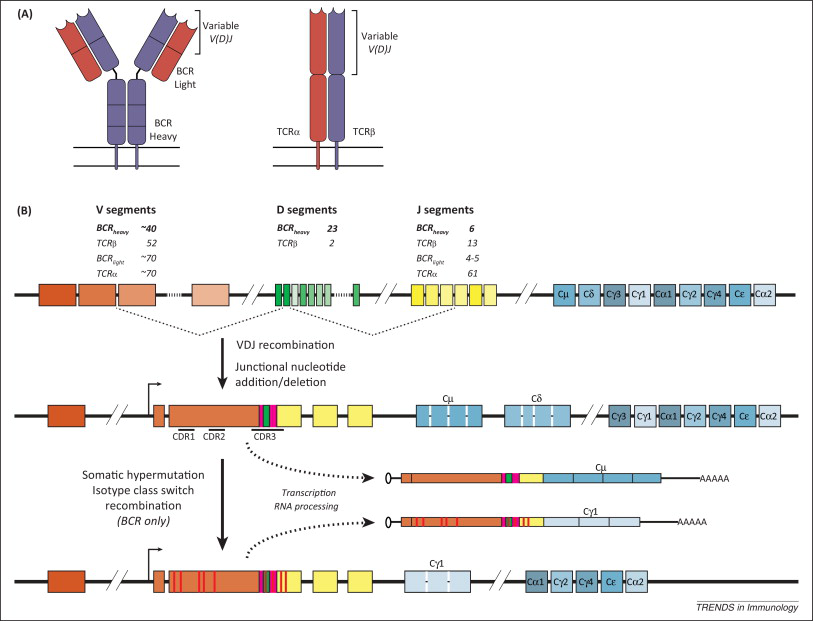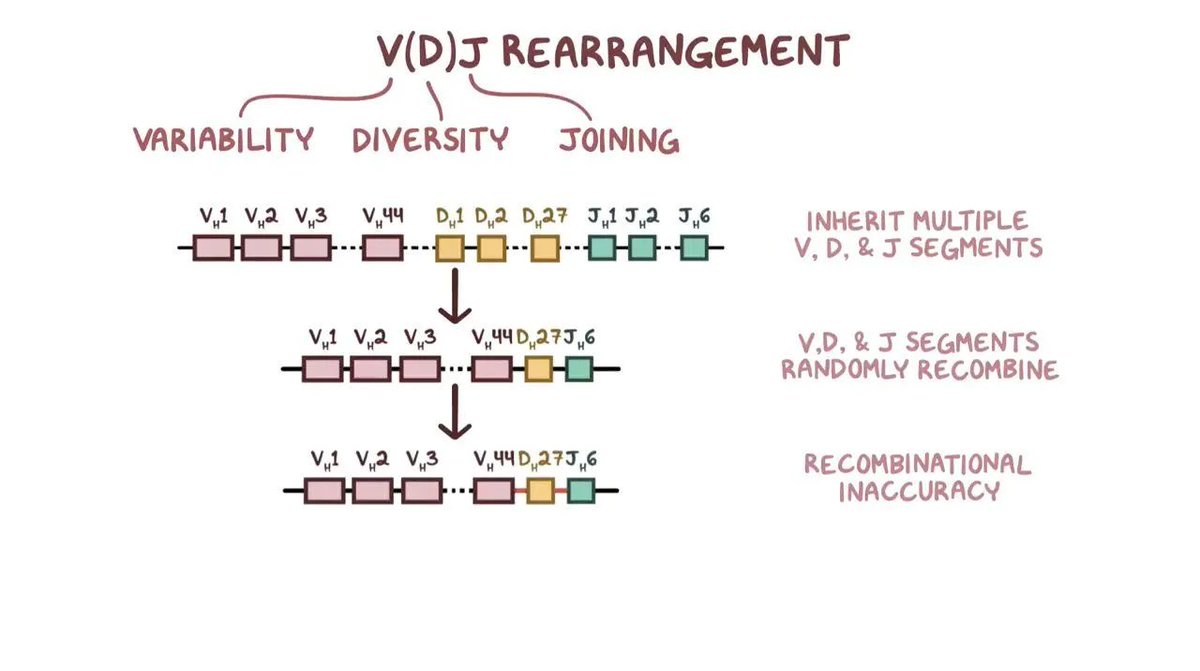
1/ Both T cells and B cells undergo the process of genetic recombination. Their receptors are generated by randomly selecting genes from a very broad range of possible genes.
2/ This random genetic selection process is so similar between both T cells and B cells that it makes sense to cover them together. The key to remember is recombination happens at the DNA level, and it is permanent. 

3/ When it comes to selecting genes, each cell must choose randomly from three different classes of genes with Variable, Diversity and Junctional classes. This is where the recombination process gets its name as VDJ recombination.
4/ Each Variable gene will have many possible genes to chose from just as each Diversity and Junctional will have several genes to pick from. The number of genes available to chose from depends whether it is a T cell or B cell doing the picking. 

5/ The process of recombination actually occurs with the DNA. It can only occur with one chromosome. The cell must pick the mom chromosome or the dad chromosome. This is called allelic exclusion. 

6/ The T cells have two chains with the Alpha chain and the Beta chain. The Beta chains will chose a Variable from 52 possible gene choices, then a Diversity from 2 possible gene choice, and finally a Junctional from 13 possible gene choices. 

7/ The Alpha chain only chooses from 70 Variable gene choices and then from 62 Junctional gene choices. This allows every T cell to have a completely unique receptor for recognizing a wide variety of antigens.
8/ The B cells have two chains to chose from with the Heavy chain and the Light chains. There are two different light chains for the B cells with kappa and lambda light chains.
9/ Both these light chains use the same genes with 70 Variable gene choices and 5 Junctional gene choices. They just do it from different chromosomes. The kappa light chain draws its genes from Chromosome 2 while the lambda light chain draws its genes from chromosome 22.
10/ The Heavy chain of the B cell will pick from 40 possible Variable gene choices, 23 Diversity gene choices and 6 Junctional gene choices. This will give each and every B cell a completely unique receptor. 

11/ When all three VDJ genes come together, they create three special regions of the receptor called Complemntarity Determining Regions (CDR) regions. The Variable gene makes up the CDR1 and CDR2 regions while the Diversity (when used) and Junctional make up the CDR3 region.
12/ The area of the CDR3 is the most variable region of the entire receptor being called the hypervariable region. This applies to both the T cell and B cell receptors. 

13/ The process of recombination regulated by a few elements. The first it called the Recombination Signaling Sequences (RSS). These are special sequences at the begging and end of every gene from the Variable, Diversity and Junctional genes. 

14/ The RSS sequences ensure the genes get spliced together in the right way. Each has a set of heptamer and nonamer that are like pointers to show the right direction. The 12 and 23 segments ensure that the V, D and J segments get put together in right order.
15/ Then comes the Recombination Activating Genes (RAG). The RAG enzymes will randomly land on one of the RSS sequences for the Variable and Diversity genes. Then they fold the DNA and cut it. They will take one Variable gene and paste it to one Diversity gene. 

16/ Everything else is rolled up and discarded. This leads the cell having just one of the Variable and Diversity genes. Then the RAG proteins will land on a random Junctional gene and cut and paste that to the Variable and Diversity it previously selected. 

17/ There are several enzymes that come together to paste the DNA back together after it is cut by the RAG enzymes. The key one is Terminal Deoxynucleotidyl Transferase (TDT) which is important to spicing the two pieces of DNA back together. 

18/ When this process occurs, an enzyme will clean up the ends of the DNA by removing some nucleotides. Then another enzyme will randomly add extra nucleotides between the two genes splicing them back together.
19/ This further adds more diversity to each and every T cell or B cell receptor that is created. The random insertion of a few nucleotides in that junctional splicing makes every T cell and B cell receptor unique building a very diverse population.
• • •
Missing some Tweet in this thread? You can try to
force a refresh






